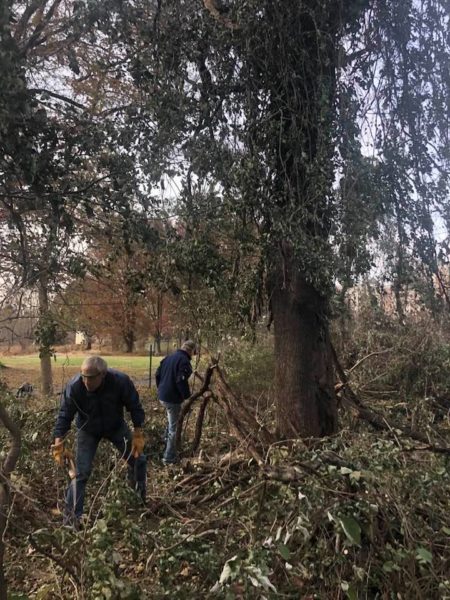by Carl Gold
There is an old guy in the woods. Gray turning to white whiskers. A broad brimmed hat with a wild turkey feather in the band. A well-worn barn coat hangs loosely on uneven shoulders. He wears thick sallow colored gloves. Perhaps alarmingly to the casual observer, two sheaths hang from his right hip. The first is 15 inches long containing a wickedly sharp curved tooth saw. The second has a six-inch blade, serrated on one side and razor sharp on the other. The blade is complemented by a well-oiled, but old, pair of secateurs.
Is he a postmodern survivalist? A hunter come to harvest his kill? A supplicant preparing for an ancient ritual?
Nope. It’s a modern day Weed Warrior, certified by the Baltimore City Arborist. It’s me. I’m doing battle against nonnative invasive vines that are girdling and killing trees and grasses and shrubs that destroy native biodiversity.

Woodlands, roadsides and lawns in Maryland are under siege from these invaders. They are not native, so nothing eats them. They crowd out everything, from spring ephemerals to understory trees. They are favorite hosts for deer ticks and are a big reason Lyme disease is so prevalent. They include ground covers, like Japanese stilt grass; shrubs, like Japanese barberry; and robust vines like Asian Bittersweet, Porcelain Berry, English ivy and Morrow’s honeysuckle. Many spread when birds eat the berries, and others multiply via windborne seeds.
Perhaps the fiercest invasive is multiflora rose, first brought to this country in 1866 as hardy rootstock for ornamental roses. It was also used as a living fence to hem in livestock and is still being used in some states on highway median strips to reduce headlight glare. Like a drunken guest who refuses to leave once he outstays his welcome, it fights back. It has hooked shaped thorns that not only penetrate unprotected skin, but lodge in — hence the barn coat, with its tight weave, and thick leather gloves. The safest approach is to remove all the pendulous branches from one side with secateurs and create a vertical plane. Then, step on the trimmed side and push it down, using the sharp saw to cut as close to its base as possible. Japanese barberry (imported in 1875 as an ornamental) has to be treated the same way, as it, too, is covered with dense spiny thorns.
More intimidating looking from a distance, but far easier to fight, is Asian Bittersweet vine. It also was imported in the 1860s as an ornamental plant. The vine can reach 6 inches or more in diameter and crawl up to the top of the forest canopy. It creates dense shade that weakens its unwilling hosts and ultimately becomes so heavy that it can uproot a tree. As it wraps around the trunk, it chokes the tree’s respiratory system. Despite its thickness and height, it yields easily to a sharp saw. Rather than try to pull it off the tree, the best practice is to cut a foot long window separating the vine from its roots. The upper portion will dry out and fall on its own. Similar treatment will save a tree from English ivy. Still widely sold as a trouble-free ground cover, it loves to leap up tree sides. As it flourishes it impedes photosynthesis and harbors pathogens deadly to native trees. Carefully use a knife to remove the vine from the bark and then treat it the same as bittersweet.

Perhaps the most prevalent invasive in the metropolitan area is Japanese stilt grass. It most likely came to the United States as packing material for Japanese porcelain in the early 1900s. Since nothing eats it, it crowds out native wildflowers. Since it is shallow rooted, it increases erosion. It flourishes in sun, shade, wet or dry conditions. Each plant can produce up to 1,000 seeds. The best approach is to pull it up or mow it down before it goes to seed.
Want to help? Want to learn more? Baltimore City offers free training by certified arborists. Just contact the Urban Forestry Division of Baltimore City Parks and Recreation Department (410-396-6109) or TreeBaltimore (baltimoretreetrust.org) to find out when the next class starts.
In the meantime, I’ll see you in the woods.
